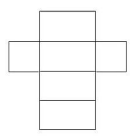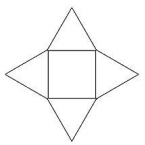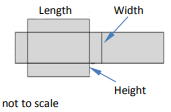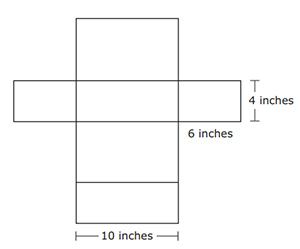Clusters should not be sorted from Major to Supporting and then taught in that order. To do so would strip the coherence of the mathematical ideas and miss the opportunity to enhance the major work of the grade with the supporting clusters.
- Assessment Limits :
Numbers in items must be positive rational numbers. Three-dimensional figures are limited to rectangular prisms, triangular prisms, rectangular pyramids, and triangular pyramids. - Calculator :
No
- Context :
Allowable
- Test Item #: Sample Item 1
- Question:
A net is shown.

What three-dimensional figure is represented by the net?
- Difficulty: N/A
- Type: MC: Multiple Choice
- Test Item #: Sample Item 2
- Question:
A net is shown.

What three-dimensional figure is represented by the net?
- Difficulty: N/A
- Type: MC: Multiple Choice
- Test Item #: Sample Item 3
- Question: The surface area of a rectangular prism is 115 square inches. The net of the prism is
shown.

What are the possible dimensions of the prism?
- Difficulty: N/A
- Type: MC: Multiple Choice
- Test Item #: Sample Item 4
- Question:
Carl is shipping a cardboard box that is a rectangular prism. The net of Carl's box is shown.

What is the area of cardboard, in square inches, required for Carl's box?
- Difficulty: N/A
- Type: EE: Equation Editor
Related Courses
Related Access Points
Related Resources
Formative Assessments
Lesson Plans
Problem-Solving Task
Student Center Activity
Tutorials
Unit/Lesson Sequences
STEM Lessons - Model Eliciting Activity
In this MEA, students select jars for candles based on a variety of factors and then design boxes to contain the jars.
Model Eliciting Activities, MEAs, are open-ended, interdisciplinary problem-solving activities that are meant to reveal students’ thinking about the concepts embedded in realistic situations. Click here to learn more about MEAs and how they can transform your classroom.
This MEA will have students determining the safest and most cost effective material to use when building a tree house.They will do this by calculating surface area and determining cost.
Model Eliciting Activities, MEAs, are open-ended, interdisciplinary problem-solving activities that are meant to reveal students’ thinking about the concepts embedded in realistic situations. MEAs resemble engineering problems and encourage students to create solutions in the form of mathematical and scientific models. Students work in teams to apply their knowledge of science and mathematics to solve an open-ended problem while considering constraints and tradeoffs. Students integrate their ELA skills into MEAs as they are asked to clearly document their thought processes. MEAs follow a problem-based, student-centered approach to learning, where students are encouraged to grapple with the problem while the teacher acts as a facilitator. To learn more about MEAs visit: https://www.cpalms.org/cpalms/mea.aspx
In this Model Eliciting Activity, MEA, students are asked to develop a procedure to fit the most amount of rectangular prism plant packages on one sheet of cardboard, using nets and surface area.
Model Eliciting Activities, MEAs, are open-ended, interdisciplinary problem-solving activities that are meant to reveal students’ thinking about the concepts embedded in realistic situations. Click here to learn more about MEAs and how they can transform your classroom.
MFAS Formative Assessments
Student Resources
Student Center Activity
Students can practice answering mathematics questions on a variety of topics. With an account, students can save their work and send it to their teacher when complete.
Type: Student Center Activity
Tutorials
This video demonstrates how to construct nets for 3-D shapes.
Type: Tutorial
This video demonstrates using a net to find surface area.
Type: Tutorial







